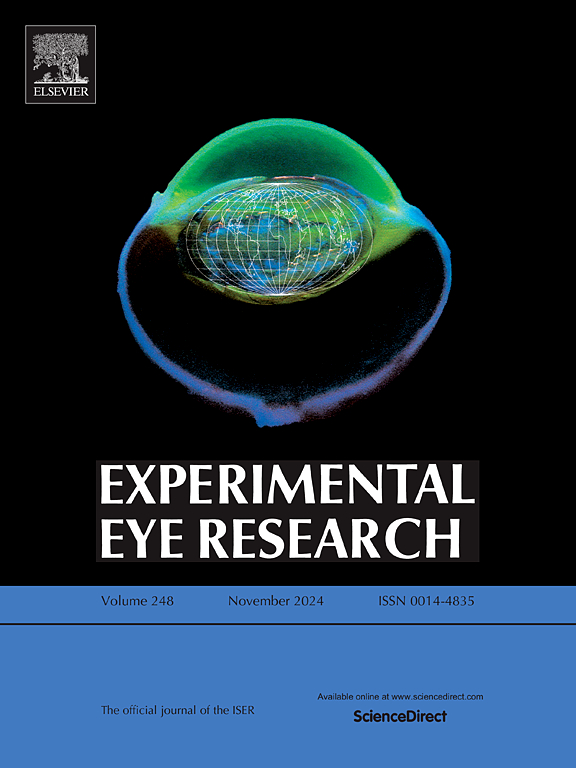DAPL1 inhibits epithelial-mesenchymal transition of retinal pigment epithelial cells by regulating the TGF-β/MITF pathway
IF 2.7
2区 医学
Q1 OPHTHALMOLOGY
引用次数: 0
Abstract
Epithelial-mesenchymal transition (EMT) of the retinal pigment epithelium (RPE) is a critical factor in the development of retinopathies, including proliferative vitreoretinopathy (PVR) and age-related macular degeneration (AMD), which are the leading causes of blindness worldwide. Deficiency in DAPL1 can induce RPE-EMT in vivo, and Dapl1 knockout mice (Dapl1 −/−) are prone to PVR, while aged Dapl1 −/− mice display AMD-like pathological features. However, the molecular mechanisms through which DAPL1 regulates RPE-EMT remain largely unknown. Here, using Dapl1 −/− mice and DAPL1 knockdown or overexpression RPE cells, we show that DAPL1 inhibits RPE-EMT by regulating the TGF-β/MITF signaling pathway, a critical signaling pathway/transcription factor in RPE cells. Overexpression of DAPL1 inhibits TGF-β-induced RPE-EMT, while deletion of Dapl1 in mice activates TGF-β signaling, decreases MITF expression, and promotes RPE-EMT under physiological or PVR pathological conditions. Gene therapy demonstrates that transgenic overexpression of MITF in Dapl1 −/− mice inhibits RPE-EMT in vivo and prevents retinal detachment-induced PVR pathological progress, offering hope for future treatment. Similarly, pharmacological therapy with Isoviolanthin, a flavonoid glycoside isolated from traditional medicinal herbs, inhibits TGF-β signaling and increases MITF expression in RPE cells in Dapl1 −/− mice, which then effectively rescues experimental PVR in Dapl1 −/− mice. These results suggest that DAPL1 regulates RPE-EMT at least partial through the TGF-β/MITF pathway and that targeting the TGF-β/MITF pathway could be a potential therapeutic strategy to treat Dapl1 deficiency-induced RPE-EMT-related retinal diseases, instilling hope for the future of retinal disease treatment.
DAPL1通过调控TGF-β/MITF通路抑制视网膜色素上皮细胞上皮-间质转化
视网膜色素上皮(RPE)的上皮-间质转化(EMT)是视网膜病变发展的关键因素,包括增殖性玻璃体视网膜病变(PVR)和年龄相关性黄斑变性(AMD),这是全球失明的主要原因。体内缺乏DAPL1可诱导RPE-EMT,并且DAPL1敲除小鼠(DAPL1−/−)容易发生PVR,而老年DAPL1−/−小鼠表现出amd样病理特征。然而,DAPL1调控RPE-EMT的分子机制在很大程度上仍然未知。在这里,我们使用Dapl1−/−小鼠和Dapl1敲低或过表达的RPE细胞,我们发现Dapl1通过调节TGF-β/MITF信号通路抑制RPE- emt, TGF-β/MITF信号通路是RPE细胞中的关键信号通路/转录因子。DAPL1过表达抑制TGF-β诱导的RPE-EMT,而在小鼠生理或PVR病理条件下,DAPL1缺失激活TGF-β信号,降低MITF表达,促进RPE-EMT。基因治疗表明,在Dapl1−/−小鼠中转基因过表达MITF可抑制体内RPE-EMT,并阻止视网膜脱离引起的PVR病理进展,为未来的治疗提供了希望。类似地,异violanthin(一种从传统草药中分离的黄酮类苷)的药物治疗可以抑制Dapl1−/−小鼠RPE细胞中TGF-β信号传导并增加MITF表达,从而有效地挽救实验性的dpl1−/−小鼠PVR。这些结果表明,DAPL1至少部分通过TGF-β/MITF途径调节RPE-EMT,靶向TGF-β/MITF途径可能是治疗DAPL1缺陷诱导的RPE-EMT相关视网膜疾病的潜在治疗策略,为未来的视网膜疾病治疗注入了希望。
本文章由计算机程序翻译,如有差异,请以英文原文为准。
求助全文
约1分钟内获得全文
求助全文
来源期刊

Experimental eye research
医学-眼科学
CiteScore
6.80
自引率
5.90%
发文量
323
审稿时长
66 days
期刊介绍:
The primary goal of Experimental Eye Research is to publish original research papers on all aspects of experimental biology of the eye and ocular tissues that seek to define the mechanisms of normal function and/or disease. Studies of ocular tissues that encompass the disciplines of cell biology, developmental biology, genetics, molecular biology, physiology, biochemistry, biophysics, immunology or microbiology are most welcomed. Manuscripts that are purely clinical or in a surgical area of ophthalmology are not appropriate for submission to Experimental Eye Research and if received will be returned without review.
 求助内容:
求助内容: 应助结果提醒方式:
应助结果提醒方式:


